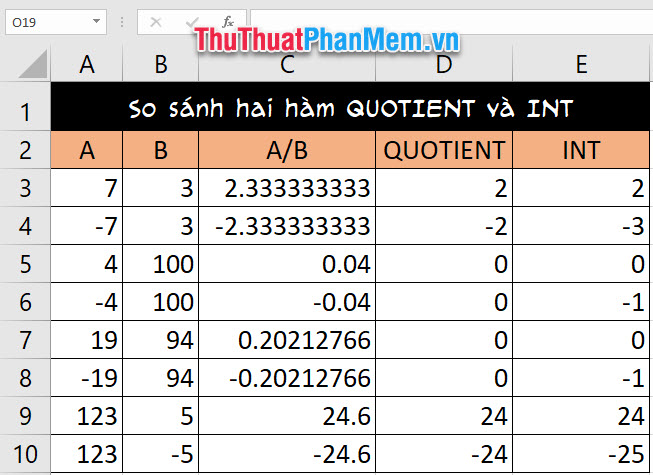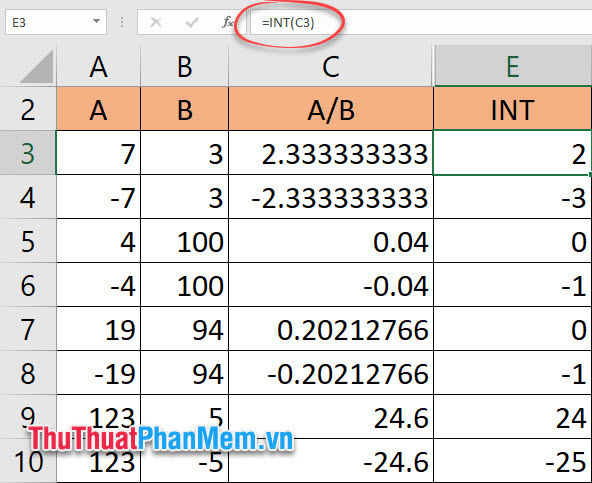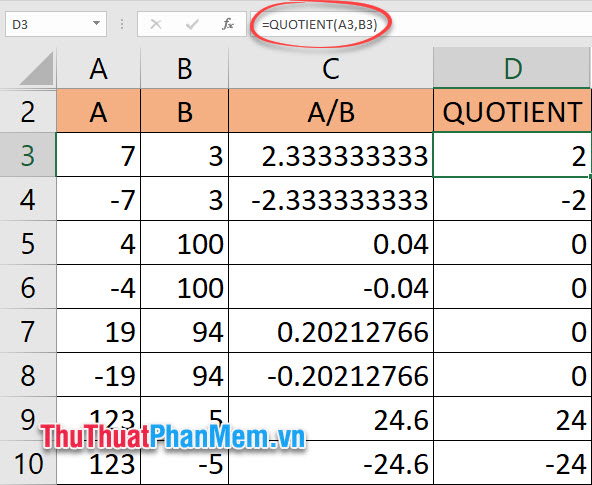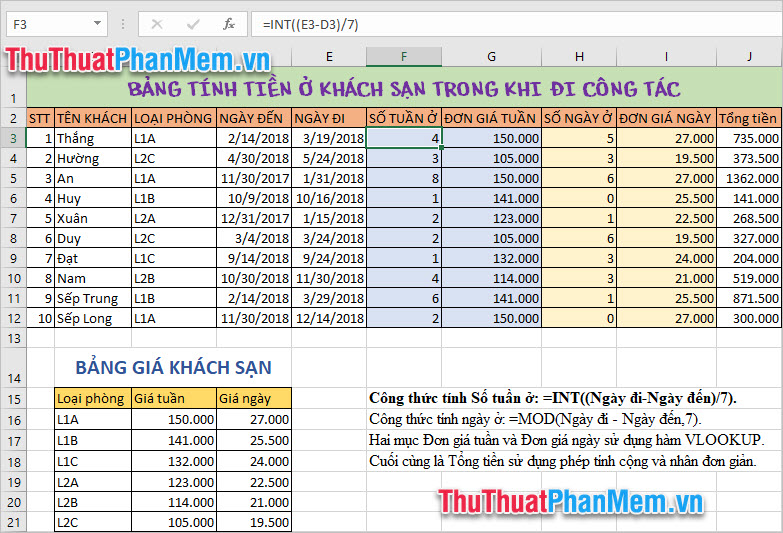The function takes whole parts in Excel - Specific examples

Excel has 2 functions that involve taking integer parts: QUOTIENT , INT . There are many people who have a confusion between these two functions, only when you understand the nature of each one can you use them most accurately. In this article TipsMake.vn will clarify more about those two functions.
1. What is the integer part? Related issues.
Integers are numbers that include positive integers (1, 2, 3, .), negative integers (−1, −2, −3, .) and 0.
A rational number is a real number that can be expressed as a fraction (quotient) a / b, where a and b are integers with b other than zero. The rational number can be a finite number of decimal places or a decimal number. Cyclic infinite stool.

An irrational number is a real number that is not a rational number, meaning it cannot be expressed as a / b ratio (where a and b are integers).

All real numbers (including rational and irrational) can be written as:
x = n + z
where: n is an integer
0 ≤ z ≤ 1
The integer is the largest integer that does not exceed it. The symbol of the integer is [x], where x is a real number.
The decimal fraction of real numbers is determined by subtracting the whole numbers from that real number. The notation for the decimal part is {x}, where x is a real number.
Many people understand that the integer part is the number before the comma and the decimal part is the number after the comma , but this is only true when you are considering that a positive real number is wrong with a negative real number. For example, we have:
9.4 is a positive real number, where 9 is an integer and 4 is a decimal.
But with -9.4, the part before the comma -9 is not the whole part because -9> -9.4
In this case -9.4 = -10 + 0.6 with -10 is the integer part of -9.4
2. The function takes an integer part in Excel
Let's look at an example of the following table:

Where we have a and b are integers with b other than zero. We have the effect of a and b are rational numbers or here we need to consider is the numbers with both integers and decimals.
The 'take integer' result of QUOTIENT and INT will produce the same result if it is positive number and different if it is negative number.
Based on the integer part theory, we can see that the INT function is exactly the integer function and the QUOTIENT function is just the function that takes the number of digits before the comma.
2.1. How to use the integer get function
The integer integer fetch function has the formula:
= INT (number to be taken)
In which the number to take integer can be a specific number or a cell address.

Note: The INT function only accepts numeric data (and only a number), so when entering data for INT with two or more numbers, you need to insert the calculations, for example:
= INT (7/3)
2.2. How to use the function to get the part before the comma QUOTIENT
The QUOTIENT function has the formula:
= QUOTIENT (dividend, divisor)
In which the divisor must always be non-zero.

Unlike INT function, QUOTIENT function does not need to be calculated separately because it is already a division itself.
3. Practical examples
Thuthuatphanmem.vn Company allows employees to go on business trips on different occasions. The finance department needs to calculate the number of weeks and days spent at the hotel to pay the staff.
Data are given as hotel arrival and departure dates together with price list for room types.

In the Number of weeks in, we can use the INT function to calculate.
The diagram here is to calculate the number of days then spend 7 to calculate the number of weeks. But the days in the hotel are not all week round because we can stay odd days so we only get the whole result.
Therefore, the calculation function is given as:
= INT ((Departure - Arrival) / 7))
The article about taking functions in Excel is here now, thank you for following the article of TipsMake.vn . Wish you can do it successfully!
You should read it
- DCount function in Excel - How to use the DCount function and examples using the DCount function
- INDIRECT function in Excel - How to use INDIRECT function and examples using INDIRECT function
- Offset function in Excel - Usage and examples
- IRR function in Excel - Usage and examples
- Function Address - The function returns the address of a cell in Excel (usage, examples, examples)
- Excel date function - Usage and examples
- The MID function in Excel, how to use the MID function, and examples
- DSUM function in Excel, how to use DSUM function and examples
May be interested
- Excel date function - Usage and examples
 the date counting function in excel is one of the most effective functions of this software. because excel usually works in the field of statistics and calculations, it is extremely necessary to record dates. to help you understand this function, let's come to the following article of tipsmake.
the date counting function in excel is one of the most effective functions of this software. because excel usually works in the field of statistics and calculations, it is extremely necessary to record dates. to help you understand this function, let's come to the following article of tipsmake. - The MID function in Excel, how to use the MID function, and examples
 the mid function in excel, how to use the mid function, and examples. the mid function in excel is a function of the text function group, you use the mid function if you want to cut the string in the middle of the text string when processing the string. if you do not know or do not understand the mid function, then you
the mid function in excel, how to use the mid function, and examples. the mid function in excel is a function of the text function group, you use the mid function if you want to cut the string in the middle of the text string when processing the string. if you do not know or do not understand the mid function, then you - DSUM function in Excel, how to use DSUM function and examples
 dsum function in excel, how to use dsum function and examples. the dsum function in excel is a fairly common function with a fairly simple usage. but if you do not know how to use the dsum function, you can refer to the following article to understand h
dsum function in excel, how to use dsum function and examples. the dsum function in excel is a fairly common function with a fairly simple usage. but if you do not know how to use the dsum function, you can refer to the following article to understand h - How to use the IF function with VLOOKUP (examples and how to)
 how to use the if function in combination with vlookup (examples and how to do it). if you are looking to use the if function with vlookup with specific examples, please refer to the following article. the following article will guide you 3 common cases using the if function
how to use the if function in combination with vlookup (examples and how to do it). if you are looking to use the if function with vlookup with specific examples, please refer to the following article. the following article will guide you 3 common cases using the if function - PMT function in Excel - Usage and examples
 the pmt function is one of the built-in financial functions of the excel software used to calculate the payment for a loan based on regular payments and a constant interest rate. the pmt function is not only useful for businesses, but also very practical for users if you want to calculate a loan.
the pmt function is one of the built-in financial functions of the excel software used to calculate the payment for a loan based on regular payments and a constant interest rate. the pmt function is not only useful for businesses, but also very practical for users if you want to calculate a loan. - How to use the MAXA function in Excel, detailed examples
 the maxa function in excel helps find the largest value in a data set, including numbers, logical values, and text containing numbers. this is different from the max function, which only counts numbers. let's learn the syntax and usage of the maxa function with practical examples.
the maxa function in excel helps find the largest value in a data set, including numbers, logical values, and text containing numbers. this is different from the max function, which only counts numbers. let's learn the syntax and usage of the maxa function with practical examples. - IFS function in Excel, usage and specific examples
 what is the ifs function in excel? how to use the ifs function in excel 2016? here's everything you need to know about the ifs function in excel.
what is the ifs function in excel? how to use the ifs function in excel 2016? here's everything you need to know about the ifs function in excel. - LEFT function in Excel, how to use LEFT function and illustrative examples
 left function in excel, how to use left function and illustrative examples. left function in excel is a function of string processing function, you use left function when you need to cut the character string to the left of the text string. if you need to learn more about mid functions, be patient
left function in excel, how to use left function and illustrative examples. left function in excel is a function of string processing function, you use left function when you need to cut the character string to the left of the text string. if you need to learn more about mid functions, be patient - Round function (rounding) in Excel
 round function (rounding) in excel - the following article shows you the syntax of the round function and specific examples to help you understand and visualize more.
round function (rounding) in excel - the following article shows you the syntax of the round function and specific examples to help you understand and visualize more. - How to use the SUMIF function in Excel
 the sumif function in excel is a function used to compute values in a specified range. the sumif function can be used for summing cells based on the date, data and text that are connected to the specified area.
the sumif function in excel is a function used to compute values in a specified range. the sumif function can be used for summing cells based on the date, data and text that are connected to the specified area.










 How to merge cells in Excel with no data loss
How to merge cells in Excel with no data loss How to move photos, change the image position in Word
How to move photos, change the image position in Word How to convert uppercase to lowercase in Excel simple and fast
How to convert uppercase to lowercase in Excel simple and fast How to print a PDF file - The easiest way to print a PDF document
How to print a PDF file - The easiest way to print a PDF document How to insert and copy PDF files into Word quickly and standardly
How to insert and copy PDF files into Word quickly and standardly